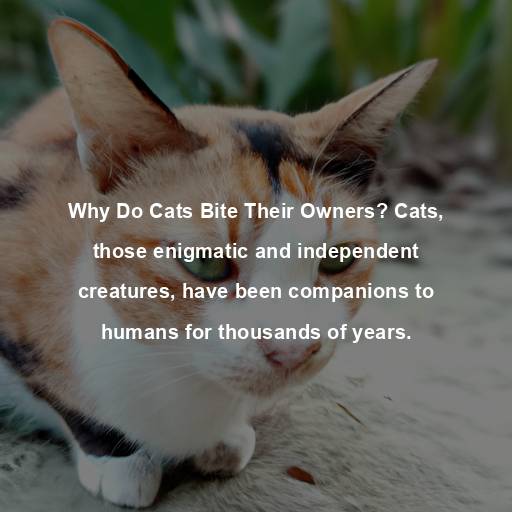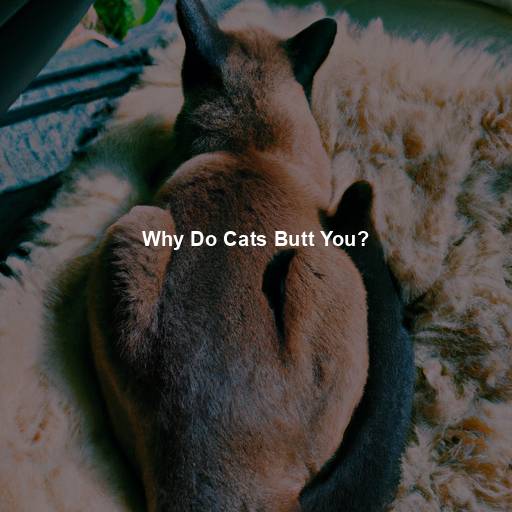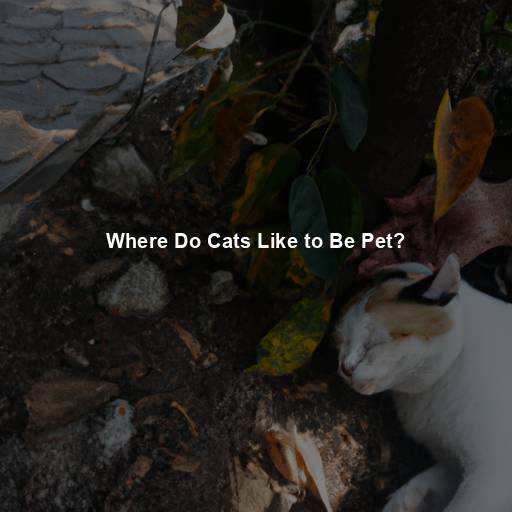Why Do Cats Bite Their Owners? Cats, those enigmatic and independent creatures, have been companions to humans for thousands of years.
Last Updated on July 23, 2023 by Evan
Their playful antics, soothing purrs, and mesmerizing gaze have captivated the hearts of many. However, there are times when our feline friends exhibit behavior that leaves us puzzled and even injured. One such behavior is biting.
Contents
Understanding the Nature of Cats
As we embark on unraveling the perplexing enigma of cat biting, it becomes apparent that comprehending the intricate makeup of these feline beings is pivotal. Cats, with their enigmatic charm, harbor an innate curiosity and primal instincts, reminiscent of their wild ancestors. Resultantly, their actions often leave us baffled, prompting us to ponder and inquire into the motives behind their mysterious behaviors.
Communication Through Biting
One of the primary reasons cats bite their owners is communication. Unlike humans, cats do not possess a vast repertoire of verbal language. Instead, they rely on a complex system of body language and vocalizations to convey their emotions and intentions. Biting can be a form of communication, indicating a range of emotions from affection to frustration or even fear.
Playful Biting
As feline enthusiasts, we are captivated by the innate hunting abilities of cats, which stem from eons of evolution. The playful nature of kittens and young cats often manifests in spirited bouts of biting, honing important survival techniques. Though when our beloved feline friends engage in playful banter with us, their exuberant bites occasionally transcend the boundaries of exuberance, leading to unwitting scratches or nibbles.
Territory and Dominance
In the fascinating world of feline behavior, cats reveal their captivating complexity. Their territorial nature is a microcosm of their unique personalities, with a strong inclination towards asserting their dominance and establishing boundaries. The intriguing phenomenon of biting often unfolds in multi-cat households or when a new member enters the purrfect realm of the existing feline residents, adding a layer of bewilderment and complexity to their social dynamics.
Overstimulation or Fear
Cats, those enigmatic creatures of unpredictable moods and intricate inner workings, possess a delicate sensitivity that can render them susceptible to the tumultuous whirlwind of overwhelming situations and stimuli. In such moments of fragility, their defenses may be unexpectedly aroused, leading to the dreaded manifestation of biting. To ward off this brewing tempest of feline angst, vigilance in deciphering the subtle language of their bodies becomes paramount, coupled with the provision of an oasis of serenity where fear-induced biting may find no fertile ground to sprout its perplexing seeds.
Common Misconceptions
Now that we have explored some of the reasons behind cat biting, it’s essential to address common misconceptions surrounding this behavior. Misconceptions can perpetuate misunderstanding and hinder the development of a healthy bond between cats and their owners.
Cats Bite Out of Spite
It’s a common misconception that cats bite out of a deep-rooted desire to harm or seek revenge. In reality, these feline creatures cannot hold grudges or plot malicious schemes. Their biting behavior is often a way to communicate or respond to certain triggers, rather than a deliberate act of spite. Understanding the intricacies of feline behavior can help decode the perplexing nature of these mesmerizing creatures.
Biting is Always Aggressive Behavior
While biting can be a form of aggression, it is not always an aggressive behavior. As mentioned earlier, cats may bite during play or as a means of communication. It is crucial to distinguish between aggressive biting and other types of biting to understand the underlying motivations accurately.
All Biting Behaviors are the Same
When it comes to feline behavior, biting can sometimes leave us scratching our heads in confusion. Cats are complex creatures, and their biting habits can be as diverse as their personalities. From gentle nips to powerful chomps, it can be perplexing to decipher the meaning behind each bite. However, by paying close attention to the situation and observing your cat’s body language, you can start unraveling the enigma behind these unpredictable gestures.
Tips for Preventing Cat Biting
Now that we have explored the reasons behind cat biting and dispelled common misconceptions, let’s discuss some practical tips for preventing and managing this behavior. By implementing these strategies, you can create a harmonious environment for both you and your feline companion.
Understand Your Cat’s Body Language
Cats communicate primarily through body language. By familiarizing yourself with the subtle cues and signals your cat displays, you can better anticipate and prevent situations that may lead to biting. Dilated pupils, flattened ears, and a twitching tail are just a few examples of body language that may indicate your cat’s emotional state.
Provide Appropriate Toys and Playtime
Engaging in interactive play sessions with our feline friends is crucial, allowing them to tap into their innate hunting prowess and release their pent-up energy. By providing them with suitable toys, we can help redirect their biting tendencies towards more appropriate targets. And remember, it’s important to refrain from using our own hands or feet as playthings, as this may lead them to associate biting with human appendages. Let’s create a playful environment that promotes healthy playtime for our beloved cats.
Avoid Overstimulation
Our feline companions have their own unique preferences when it comes to stimulation. Keep a close eye on your cat’s non-verbal cues and take note of their individual limits. If you notice any signs of discomfort or restlessness, it’s essential to dial back the petting and interaction. Respecting their boundaries will not only maintain their peace of mind but also help prevent any potential nips or bites as a form of expression.
Seek Professional Guidance
If you are struggling to manage your cat’s biting behavior or if the biting is causing significant distress or injury, it is advisable to seek professional guidance. Consulting with a veterinarian or a certified animal behaviorist can provide valuable insights and tailored strategies to address the issue effectively.
The Bond Between Cats and Humans
Cats have been our companions for centuries, and their presence in our lives brings us immeasurable joy and comfort. While the occasional biting incident may occur, understanding the underlying reasons behind this behavior allows us to foster a stronger bond with our feline friends. By respecting their instincts, providing appropriate outlets for their energy, and communicating effectively, we can navigate the complex world of cat behavior with compassion and understanding.
In the vast realm of feline mysteries, the perplexing question of why our beloved cats choose to sink their teeth into our unsuspecting flesh remains shrouded in enigmatic complexity. A melange of communication dynamics, playful instincts, territorial assertions, and deep-seated fears converge to unveil the multilayered tapestry of this puzzling behavior. As we embark on a quest to unriddle this feline enigma, dispelling common misconceptions and implementing preemptive measures hold the key to forging a serene coexistence between our bewitching companions and ourselves. So, let us embark on an exploration of deciphering the cryptic signals encoded in the captivating body language of our enigmatic feline friends, celebrating the enigmatic bond that intertwines our lives with theirs.
Understanding how our feline friends communicate is key to maintaining a harmonious relationship and minimizing the chance of pesky biting incidents. Our furry companions don’t rely solely on words; their repertoire includes a delightful mix of non-verbal signals like purrs, meows, and subtle body movements. From their expressive faces to intriguing body postures, cats skillfully convey their emotions and intentions. By decoding these cues, we can become adept at understanding their needs and desires, ultimately preventing any potential biting mishaps.
Tail Position
Unlocking the enigmatic language of feline communication lies within the captivating realm of their tails. These remarkable appendages not only serve as an elegant extension of their grace but also harbor a treasure trove of emotional revelations. A tail held aloft in a relaxed and upright position unveils a tranquil and amiable demeanor, like a soothing melody whispered in the language of felinity. On the contrary, a tail that fluffs up, defying the ordinary, or lashes about with fervor may signal an unsettling inner turmoil – a dance of unease or trepidation.
Ears
It’s fascinating how cats have this enigmatic way of communicating their emotions through their ears. The way their ears stand tall and face forward when they’re curious and engaged shows just how in tune they are with their surroundings. However, when their ears flatten against their head, it’s like a silent alarm signaling fear, aggression, or unease. By closely observing these subtle ear movements, you’ll have a better understanding of your feline companion’s comfort levels, ensuring a harmonious coexistence and steering clear of any unexpected biting scenarios.
Pupil Dilation
The size of a cat’s pupils can provide insight into their emotional state. Dilated pupils often indicate excitement, fear, or arousal. Conversely, constricted pupils may indicate relaxation or contentment. By observing the size of your cat’s pupils, you can better understand their mood and adjust your interactions accordingly.
Body Posture
The fascinating world of feline nonverbal communication unravels before us, as we peel back the layers to unravel the enigma of a cat’s body posture. With an air of elegant mystique, these enigmatic creatures speak volumes through the fluidity of their form. A relaxed cat, with their tail held high like a proud banner, exudes an aura of tranquility, whilst the tense and rigid contortions of a low-to-the-ground stance may cloak a hidden fear or simmering aggression. Mastering the art of deciphering these visual codes may just save you from a perilous encounter with sharp teeth and claws.
Environmental Enrichment for Cats
Providing a stimulating and enriching environment is essential for a cat’s overall well-being and can help prevent biting behaviors. Cats are natural hunters, and they require mental and physical stimulation to thrive. Here are some tips for creating an enriching environment for your feline companion:
Interactive Toys
Keeping your adorable feline entertained can be quite the head-scratcher. But fear not! Engaging your furry friend in play sessions with interactive toys is the key to untangling their wild hunting instincts and keeping their boundless energy in check. From feather wands that mimic elusive prey to those mesmerizing laser pointers, there are plenty of ways to bewitch your cat and prevent them from sinking their teeth into boredom-induced biting behaviors.
Vertical Space
As feline enthusiasts, we can all agree that cats possess an instinctual desire to conquer new heights, perch like royalty, and command a panoramic view of their surroundings. To cater to their divine cravings, it is essential for us humans to embrace the concept of vertical space — a realm where cats can truly unleash their inner majesty and establish their territorial dominion. By investing in luxurious cat trees or strategically placed shelves, we not only bestow upon our feline companions a means of mental exhilaration but also create a safe haven that cultivates a sense of security, thereby diminishing stress levels and minimizing the chances of unexpected nibbles.
Scratching Posts
Have you ever wondered why your beloved feline friend can’t resist sinking their claws into furniture and carpets? Well, worry not, because scratching is actually a natural and essential behavior for cats. It’s their way of marking their territory and keeping those precious claws in purr-fect shape. But fear not, dear human companion, for there is a solution to save your beloved decor from their savage scratches.
Hiding Places
Cats often seek out hiding spots where they can retreat and feel safe. Providing cozy hiding places, such as covered beds or enclosed cat condos, allows cats to have a designated space where they can relax and unwind. Hiding places can help reduce stress and prevent biting incidents that may arise from feeling overwhelmed or cornered.
Seeking Professional Assistance
If, despite your most sincere endeavors, your feline companion continues to engage in biting behavior, you may find yourself in a state of perplexity. However, fear not, for there is a glimmer of hope amidst this perplexing situation. Consider seeking the expertise of a veterinarian or a certified animal behaviorist, whose wisdom and knowledge can shed light on the mysterious reasons behind your cat’s behavior. With their guidance, a customized plan can be crafted to address the underlying medical issues and modify your cat’s behavior.
Medical Evaluation
Understanding the reasons behind a cat’s biting behavior can be quite puzzling. It turns out that there might be more to it than meets the eye. In fact, it could be a reaction to an underlying medical condition causing pain or discomfort. To shed some light on this, it would be wise to consult a veterinarian for a comprehensive evaluation.
Behavior Modification Techniques
Certified animal behaviorists specialize in understanding and modifying animal behavior. They can provide valuable insights into your cat’s biting behavior and develop a behavior modification plan tailored to your specific situation. Behavior modification techniques may include desensitization, counter-conditioning, and positive reinforcement training.
FAQs – Why do cats bite their owners?
Why do cats bite their owners?
Cats may bite their owners for various reasons. One common reason is that cats use biting as a form of communication. It could be their way of expressing affection or playfulness. Sometimes, cats nip or lightly bite during playtime because they haven’t learned to inhibit their biting instinct properly. It’s essential to understand a cat’s body language and recognize when a bite is a gentle love bite or a sign of aggression.
Is biting a sign of aggression in cats?
Yes, biting can be a sign of aggression in cats. When a cat feels threatened or anxious, it may resort to biting as a defense mechanism. Fear or pain can also trigger aggressive behavior in cats, causing them to bite. It’s important to identify the underlying cause of aggression and consult with a veterinarian or animal behaviorist to address the issue properly.
How can I prevent my cat from biting?
Cat biting can be an exasperating experience for any feline aficionado. But fret not, my fellow feline enthusiasts! By establishing firm boundaries and offering outlets for your furball’s boundless energy, you can conquer this perplexing problem. Engaging your whiskered wonder in stimulating play sessions with interactive toys not only redirects their primal hunting instincts but also curbs their biting urges. Moreover, appease their innate scratching cravings with a suitable scratching post and create an environment that nurtures their well-being to prevent aggressive behavior. Remember, discouraging rough play and steering clear of hand or foot nibbling is pivotal in nipping biting in the bud.
Why does my cat bite me when being petted?
Some cats may bite when being petted due to overstimulation. They reach a threshold where the pleasurable sensation of petting turns into irritation, causing them to bite as a way to communicate their discomfort. Understanding your cat’s body language and recognizing when they have had enough stimulation is crucial. Pay attention to their tail movements, ears, and overall body tension, as these can indicate their mood and comfort level.
How can I stop my cat from biting me?
Dealing with a biting cat can be quite a challenge, but fear not! There are smart strategies that you can employ to combat this perplexing behavior. It’s important to remember that your reaction plays a crucial role in shaping your feline friend’s actions. In the event of a bite, it’s best to maintain a sense of calmness and quietly disengage. Instead of dwelling on the negative, redirect their focus towards engaging toys or entice them with a playful wand or laser pointer. By consistently reinforcing positive behavior and gently discouraging their biting tendencies, you’ll be well on your way to curbing their aggressive streak.






